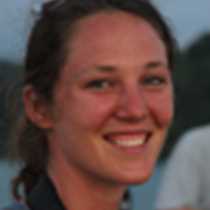Tracy Arm & Williams Cove
As the National Geographic Sea Lion made its way up Tracy Arm this morning, the guests gathered at the bow of the ship to revel in the beautiful scenery and gorgeous blue skies. The steep rock cliffs that form the narrow fjord were created thousands of years ago, beginning in the Pleistocene Era when the ice fields began to recede, leaving deep gorges in the natural landscape. Today, the North and South Sawyer glaciers that flow from the Stikine ice fields are the last remains of the giant glacial expanses that once covered the region. Instead of ice, however, the cliff faces are now lined with mineral deposits and sparsely covered with green vegetation.
Stretch class was held on the aft bridge deck and as we moved through our morning routine, we watched bits of ice float by and enjoyed the warm sun on our faces. After breakfast, the guests were loaded into Zodiacs and taken out to explore the floating icebergs, the products of actively calving glaciers.
We made our way slowly toward the far reaches of Tracy Arm, stopping to watch harbor seals as they lay in the sun on flat pieces of ice or poked their heads up out of the water, curiously eyeing our Zodiacs as we idled nearby. The seals take refuge in the narrow inlet of Tracy Arm, among other fjords, during pupping time. The ice provides protection against predators such as orca and offers a safe place for them to give birth to their young.
We also passed waterfalls that spewed glacial ice melt into the salty ocean water and we saw several groups of pigeon guillemots, easily identified by their bright red feet. The waters before South Sawyer glacier, located farther up the fjord, were paved with floating ice, giving us only a glimpse of its immense wall. So, our destination for the Zodiac tours was the face of the North Sawyer glacier, a gigantic wall of blue and white ice that rises hundreds of feet out of the water and ends in jagged wedges. As we watched the glacier, we could see bits of ice falling off into the water and one large calving resulted in a thundering crack that sounded like a gunshot.
After lunch we went ashore at Williams Cove, an inlet near the mouth of Tracy Arm. Guests had the option of going hiking, kayaking, Zodiac cruising, or even combining several activities. There were a few large ice sculptures in the bay, and many of the kayakers had fun paddling around them, getting a good look at the denseness of the ice. The hikers headed into the Tongass National Forest and walked along simple bear trails lined with devils club, blueberry bushes, and salmon berries. Although there were no sightings of the large animals, there were many signs - mainly scat and tracks - that the bears inhabit the region.
The Zodiac cruisers sped along the shores of Williams Cove, looking at white wing and surf scoters and simply enjoying the beautiful setting. After dinner, we continued out of Tracy Arm into Stephen’s Passage, searching for marine mammals and taking in the last bits of sunshine from this beautiful day.




